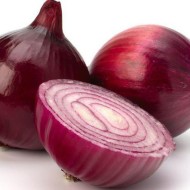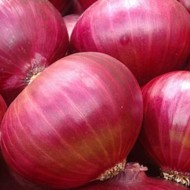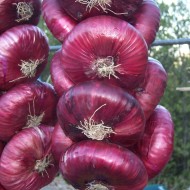The benefits and possible harm of purple and blue onions for the human body
Content
Description of purple onions
Onions are considered one of the most popular vegetable crops, which is cultivated by almost every summer resident. Depending on the varietal characteristics, the vegetable may differ in taste, aroma and even color.
The purple bow, which is often called blue or red, came to our area from distant Spain. Few know that the vegetable originally tasted bitter. And only after many years, breeders managed to get rid of the sharp bitterness in taste.
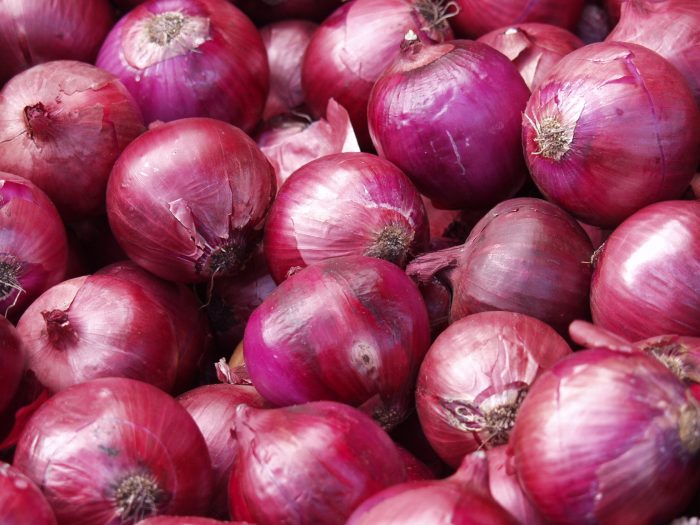
The color of the peel of sweet onions is different, but most often there are purple, red, burgundy, blue and even shades close to black. The color of the peel depends on the varietal characteristics of the crop and the characteristics of the climatic zone of growth. For example, excess moisture in the soil gives the husk a richer hue.
Calorie content and vitamin composition
The sweet variety differs from ordinary onions in the reddish, purple or lilac color of the pulp. It is the pulp of the vegetable that contains vitamins C, E, P and group B, as well as glucose, sucrose, maltose, fructose, nitrogenous substances, phytoncides, carotene and niacin. The mineral composition of the product is represented by potassium, magnesium, zinc, bromine, chromium, iodine, calcium and iron.
Nutritional value per 100 g of product - 42 kcal. The amount of carbohydrates is 9.1 g, proteins - 1.4 g, there are no fats.
Useful and medicinal properties
Sweet onions are high in antioxidants, which is why they are often used to neutralize inflammatory processes in the human body. Regular consumption of the vegetable helps to strengthen the immune system and prevents the development of malignant neoplasms.
Blue onion has anti-inflammatory, antihistamine, antimicrobial, wound healing, sugar reducing, diuretic and anthelmintic effects. It can be used for disorders of the digestive, nervous, respiratory and cardiovascular systems. The vegetable is used in cosmetology for the preparation of anti-aging and regenerating masks. Purple onions are useful for hair loss and depletion of hair follicles. Masks and infusions prepared on the basis of onion juice have a firming and tonic effect.
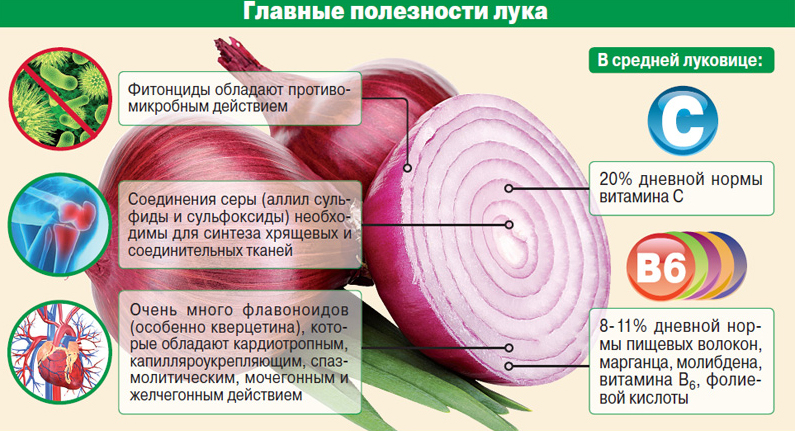
Contraindications and possible harm
The use of blue onions is not recommended for individual intolerance and a tendency to allergic reactions. Sweet and bitter varieties are contraindicated for gastritis and other pathologies of the gastrointestinal tract, pancreatitis, colitis, hypertension and asthma. An increase in acidity can cause stomach upset and a deterioration in overall well-being.
During pregnancy and breastfeeding, the vegetable is consumed in moderation. The bitterness present in the pulp is transferred to the mother's milk. As a result, a breastfed baby may refuse milk.
Video "The benefits of purple onions"
This video tells about the useful and medicinal properties of the vegetable.
Scope of the purple onion
The rich chemical composition and variety of useful properties have led to a wide range of applications for sweet onions. Purple varieties are actively used in cooking, dietetics, cosmetology and traditional medicine.
ethnoscience
Consider a few simple, but very effective recipes for traditional medicine based on purple onions:
- Nourishing hair mask. Grind 1 medium onion with a blender. Add 20 g of burdock oil. Apply the mixture to your hair. Put on a rubber cap and tie a towel. Let sit for 20-30 minutes and wash your hair thoroughly.
- Expectorant. Mix onion juice with liquid honey in a 1: 1 ratio. Take 1 tsp. 3 times a day. You need to take the "medicine" 20-30 minutes before meals. The course of treatment should not exceed 7 days.
- Anti-cold remedy. Mix onion juice and goose fat (1: 1). Rub the chest area with the prepared product. Put on a tight T-shirt or sweater, lie down under the covers. It is better to perform the procedure before bedtime.
- Means to restore the menstrual cycle. The husks of blue onions (1 kg) are poured with boiling water (500 ml), put on low heat and boiled for another 15–20 minutes. Filter the broth and take 2 tbsp. l. 3 times a day.
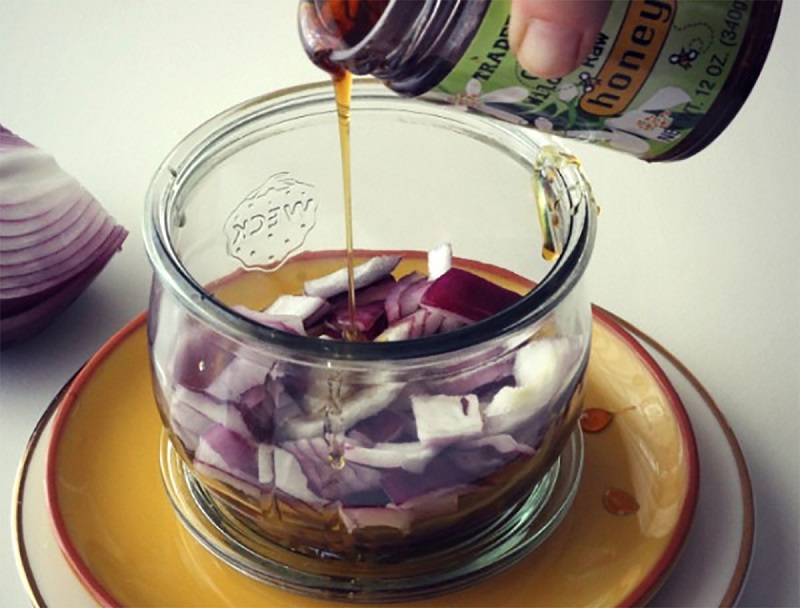
Cooking
Depending on the variety, purple bulbs can be sweet, semi-sweet, and bittersweet. The variety of taste allows the product to be used for the preparation of salads and snacks, sauces, meat and fish marinades, dumplings, dumplings and pies. Sweet onions are one of the main ingredients in first courses and side dishes.

The best varieties of sweet onions
The varieties described below are of particular attention to summer residents and housewives.
Red Baron
It is characterized by high yield rates and quick adaptation to various growing conditions. So, about 1.5 kg of vegetables are harvested from 1 m² of the garden. It can be grown both by sevka and by seed method.
The husk of the bulbs has a red-burgundy hue. The shape of the vegetable is round and slightly flattened at the top. For the Red Baron variety, a bittersweet taste is characteristic, for this reason, the vegetable is often used as an additive in the first and second courses.
Black Prince
A sweet variety for long distance transportation. Differs in a long shelf life and high yield. Under favorable weather conditions, at least 50 tons of product are harvested from 1 hectare of land. The average weight of one onion is 100 g.
The taste of the Black Prince is bittersweet. Often used for salads and vegetable dressings.
Danilovsky 301
A favorite vegetable of summer residents of the Moscow region. Danilovskiy 301 is a medium-ripening variety. Differs in stable fruiting and high maturation when stored properly. The weight of the bulb can reach 150 g. The color of the husk is deep burgundy with an admixture of a violet hue.
Commissioner
High-yielding variety. Subject to cultivation techniques, about 3–3.3 kg of juicy bulbs are harvested from 1 m² of land. The vegetable has a pleasant sweet taste and can be used for making salads and snacks. A characteristic feature of the variety is the purple color of the husk and pulp.
Alvina
The Alvina variety is distinguished by good transportability and long shelf life.When stored in a cool room, the harvested crop retains its taste and marketability for 6-7 months. The fruits are oblong and have a purple-red rind.
Yalta
There is hardly a person in Russia who does not know what a Yalta onion looks like. Strong and dense fruits are characterized by a flattened shape and rich purple color. The average weight of a bulb ranges from 200 to 250 g. A real Crimean onion has no more than 7 scales. The taste of the vegetable is sweet.
- Red Baron
- Black Prince
- Danilovsky 301
- Commissioner
- Alvina
- Yalta
Growing features
Sweet onions are grown primarily as seedlings. Sowing seeds falls on the end of February or the beginning of March.
Landing subtleties
The seeds are soaked in water, slightly dried and planted in loose fertile soil. A distance of 2-3 cm is maintained between the "beds". Containers with seeds are covered with glass or plastic wrap. The air temperature in the room should be in the range of + 22 ... + 27 ° C.
When shoots appear, the film / glass is removed. The containers are moved to a cooler place. The optimum temperature range is + 10… + 13 ° C. The seedlings are periodically watered and thinned out.
Onion planting care
Planting seedlings in open ground is carried out in early May. If the weather is cold and damp, you can postpone the procedure for 7-10 days.
Before planting in open ground, seedlings are watered abundantly. The roots and leaf part are cut off to a third of the length. Such manipulations increase the survival rate of seedlings planted in the ground.
Further care involves periodic watering and feeding. At first, onion beds require intense moisture, gradually the interval between watering increases. A few days before the onset of ripening of the bulbs, watering is completely stopped.
Organic fertilizing is carried out in May-June. Potassium-phosphorus fertilizers are applied to the soil during the formation of the bulbs.
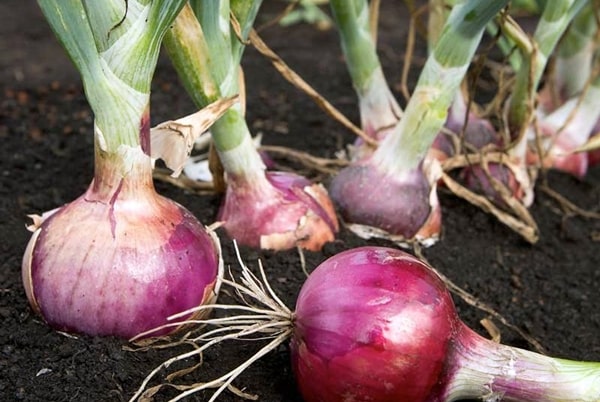
Harvesting and storage
Leaves that have turned yellow and fallen to the ground are a sign of the technical maturity of the bulbs. The harvested crop must be thoroughly dried. Even a little moisture under the husk can lead to rot.
You need to store the harvested harvest of purple onions in cardboard boxes or wooden boxes. The room should be dry, cool and periodically ventilated.
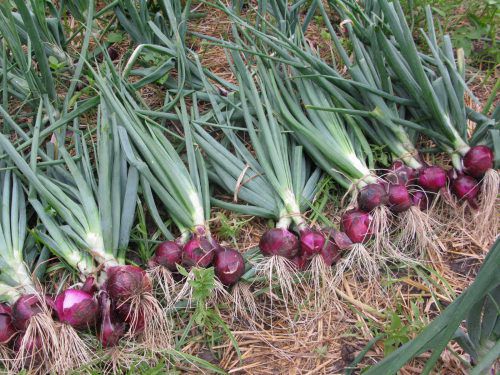
Blue onions have an interesting taste. In this case, the vegetable can be used not only for the preparation of culinary delights, but also to strengthen the immune system and prevent a number of pathologies.




